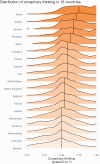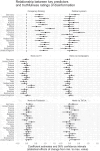Justifying an Invasion: When Is Disinformation Successful?
- PMID: 39564356
- PMCID: PMC11573309
- DOI: 10.1080/10584609.2024.2352483
Justifying an Invasion: When Is Disinformation Successful?
Abstract
Conventional wisdom suggests that social media, especially when used by authoritarian powers with nefarious aims, leaves citizens of democratic countries vulnerable to psychological influence campaigns. But such concerns overlook predispositions among recipients of false claims to reject (or to endorse) conspiratorial narratives. Analyzing responses from a survey fielded in 19 countries, we find that it is a preexisting conspiracy outlook at the individual level, more so than media diets, which consistently predicts rating Russia's pretenses for the invasion as more accurate. In all countries, individuals who view the world in general with a conspiratorial mindset are more likely to believe war-related disinformation. Receiving news via YouTube, Facebook, or TikTok is also associated with greater belief in Russian narratives justifying the invasion in several countries, but these relationships are weaker compared to those observed for conspiracy thinking. Without downplaying a potential positive role for media interventions, the findings highlight the importance of a deeper understanding of the underlying causes of conspiratorial thinking.
Keywords: Conspiracy thinking; Russia; Ukraine; conflict; public opinion; social media.
Copyright © 2024 The Author(s). Published with license by Taylor & Francis Group, LLC.
Conflict of interest statement
No potential conflict of interest was reported by the author(s).
Figures




References
-
- Aalberg, T., van Aelst, P., & Curran, J. (2010). Media systems and the political information environment: A cross-national comparison. The International Journal of Press/politics, 15(3), 255–271. 10.1177/1940161210367422 - DOI
-
- Allen, J. (2022). Misinformation amplification analysis and tracking dashboard. Integrity Institute.
-
- Altay, S., Nielsen, R. K., & Fletcher, R. (2022). Quantifying the “infodemic”: People turned to trustworthy news outlets during the 2020 coronavirus pandemic. Journal of Quantitative Description: Digital Media, 2. 10.51685/jqd.2022.020 - DOI
-
- Biden, J. R., Jr., & Carpenter, M. (2018). How to stand up to the Kremlin: Defending democracy against its enemies. Foreign Affairs, 97, 44.
LinkOut - more resources
Full Text Sources
